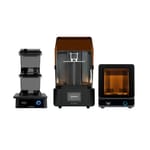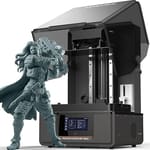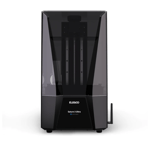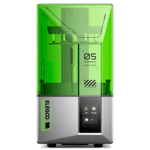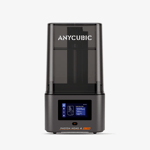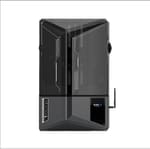Resin 3D printers have evolved a lot in the last couple of years. Today home hobbyists, makers, and professionals can pick up a compact, high-resolution machine for less than $200 and rattle off incredibly detailed prints in next to no time.
Spend a little more and you’ll get a resin 3D printing packed with sensors that tell you your printer’s state and whether there are any issues with your print. In 2025, this carries up through print volumes and price points, meaning makers looking to craft high-detail prints are spoilt for choice.
After countless hours of testing and printing, followed by no small amount of research and debate, we’ve got a list of our top resin 3D printer picks for you.
Here are the best desktop resin 3D printers, suiting all budgets, build volumes, and experience levels.
If you are unsure which is the right one for you, check out our section on how to pick a resin 3D printer to learn what you should look out for in a resin 3D printer. Or, dive right into our picks in the table below.
| Best Resin 3D Printers | Market Price (Approx., USD) | Check Price (Commissions earned) | |
|---|---|---|---|
| Ecosystem: HeyGears Ultracraft Reflex RS Combo | Professional-style simplicity; no guesswork required | $2,107 | |
| Under $1,000: Anycubic Photon Mono M7 Max | Large-format resin printing with print success smarts | $849 | |
| Under $500: Elegoo Saturn 4 Ultra 16K | Fast and smart resin 3D printing at the cutting edge | $499 | |
| Under $300: Elegoo Saturn 3 Ultra | Yesterday's mid-size flagship is today's bargain | $299 | |
| Under $200: Elegoo Mars 5 | A simple, some-frills workhorse for 2025 | $179 | |
| Small: Anycubic Photon Mono 4 Ultra | Compact, ultra-convenient resin printer with smarts | $259 | |
| Mid-Size: Elegoo Saturn 4 Ultra | Speed and print success smarts on top of a generous build volume | $399 | |
| Large: Anycubic Photon Mono M7 Max | Uncompromising features and performance for a large print volume printer | $849 | |
| Beginners: Elegoo Mars 5 | Simplicity and reliability with a low stakes price tag | $179 | |
Best Resin 3D Printer
Here are our recommendations for the best 3D resin 3D printers in their respective categories.
Ecosystem: HeyGears Ultracraft Reflex RS Combo
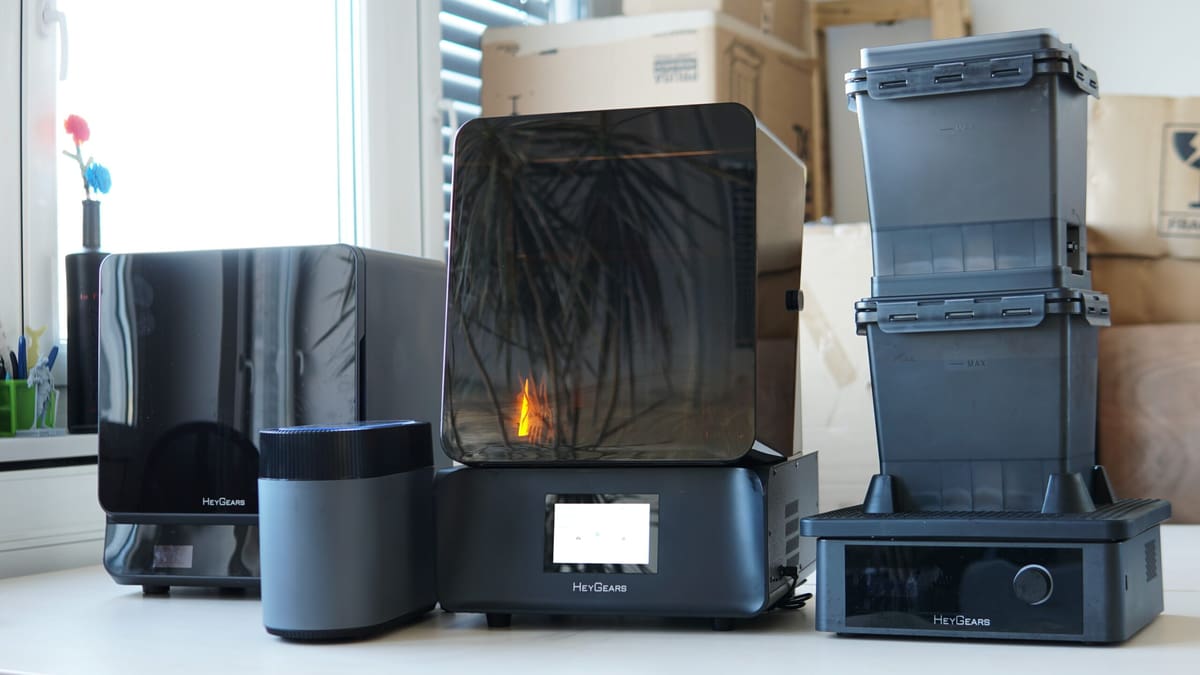
What’s Great
- One-click printing carries through wash and cure post-processing steps, too
- Pulsing release module lets you cut back on supports
- Exceptional print quality for zero effort
Ordinarily, a printer like the HeyGears Ultracraft Reflex RS would be prime under-$1,000 fodder in our buyer’s guide, but that wouldn’t accurately capture how pinpoint perfect the complete ecosystem is for this machine which, bought together, balloons the price up to $2,000+.
Most, if not all, resin 3D printer manufacturers offer peripherals, wash stations, cure boxes, and the like for their printers. HeyGears’ offering goes beyond such blunt tools to tread on the toes of the likes of Formlabs, for a fraction of the price.
It is a walled garden – a touchy subject in 3D printing, true – meaning material compatibility is limited to HeyGears’ short (but soon growing) list of resins, but within that limitation is the elimination of doubt that your print will work.
The software, Blueprint, simplifies print setup and links all of the Reflex RS 3D printer, Wash Station, and Curing Oven, letting you walk a job from printer to each step of post-processing with the stations knowing what the job is and tailoring the wash and cure cycles to the specific print.
The Reflex RS printer offers a pleasant user experience with a hinged lid and simple-to-attach print plate, and the nifty status lighting just looks cool. You get a build volume of 222 x 122 x 230 mm to work with, which puts the Reflex RS squarely in the medium-format size class.
It’s a comprehensive resin printing and post-processing solution, made even better if you throw in the Pulsing Release module and its accompanying heated resin vat. This device sits next to the printer and pumps air through channels in the heated vat to reduce the peel force in your prints. Consequently, you need fewer supports and can achieve shearer overhangs, saving material and time. It’s a thoughtful addon that to our knowledge, no other printer offers.
Under $1,000: Anycubic Photon Mono M7 Max

What’s Great
- Self-diagnostic smarts
- Heated vat as standard
- Time- and resin-saving features
With a budget ticking up to $1,000, there are two directions: big, or feature-rich. Previously, the UniFormation GKtwo was our pick for the wealth of neat little design touches that made using the printer a joy.
For $849, the Anycubic Photon Mono M7 Max does enough to pull us away by blending a large-format print volume, 298 x 164 x 300 mm, with the mod-cons of resin 3D printing in 2025. Its value lies in large-volume resin printing with plenty of success (or, rather, failure detection) systems to make it as simple as smaller-scale resin printing.
In testing, we found the system unobstructive (a rarity in large-format desktop resin printers) with the flip-hinge lid offering unrestricted access to the print chamber, and thoughtful inclusions like the integrated hook for hanging the print plate to allow resin runoff, to be genuinely useful.
A heated resin vat conditions your resin, increasing the chance of print success and, for longer, larger prints, an included resin pump can refill the vat mid-print for you. We’re not big fans of the resin pump since bottle changes can get messy – but it’s optional and you can just run the printer without it.
Overall the M7 Max is a refreshingly modern, smart, large-format resin 3d printer with a surprisingly low price tag for its size and feature set.
Under $500: Elegoo Saturn 4 Ultra 16K
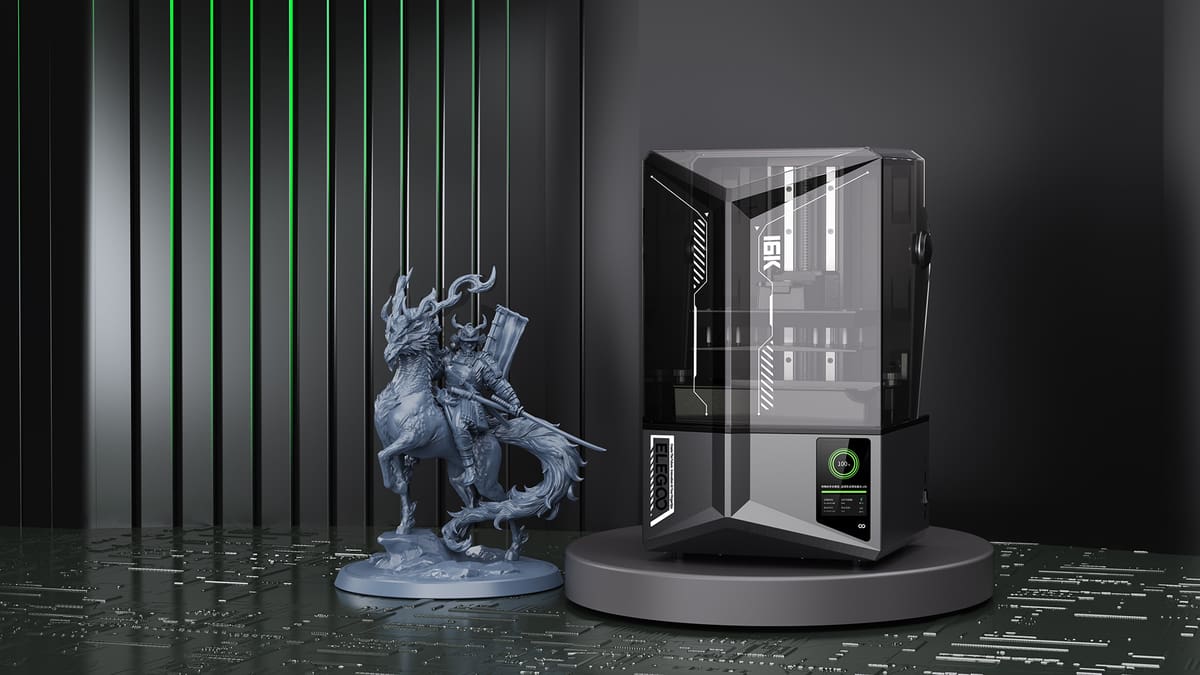
What’s Great
- Capable of fast, high-res printing
- Heated, tilting vat for fast, successful prints
- Well-implemented Wi-Fi connectivity
Our pick for a $500 budget resin 3D printer goes to the Elegoo Saturn 4 Ultra 16K, which sneaks under the line by a penny at $499.99. Going by the name alone you’d be forgiven for thinking it was just a resolution upgrade on the regular Saturn 4 Ultra, but there are a couple of killer distinctions that set the 16K apart.
For starters, the 16K introduces a heated resin vat that can condition your resin up to 30°C. This is essential for removing the environment from the equation of likely print success. Warm resin is happy resin.
And then there’s the better “AI” print monitoring camera that, this time, includes a light for 24/7 viewable time lapses and print monitoring. Sounds minor, but it’s a discernable step up in quality of life for this feature.
The build volume sits at 211 x 118 x 220 mm, shaving a couple of millimeters off the regular Saturn 4 Ultra. It’s a minor difference. Likewise, the jump up from a 12K to 16K LCD means the Saturn 4 Ultra 16K’s voxels, in the X/Y, shrink from 19×24 microns to 14×19 microns. That’s around a 20% improvement, but we’d caveat that 80% of something impossible to discern is still impossible to discern. They’re impressive numbers, but not the main attraction.
A rip-roaring mid-size flagship that offers virtually everything you could want on a modern resin 3D printer.
Under $300: Elegoo Saturn 3 Ultra
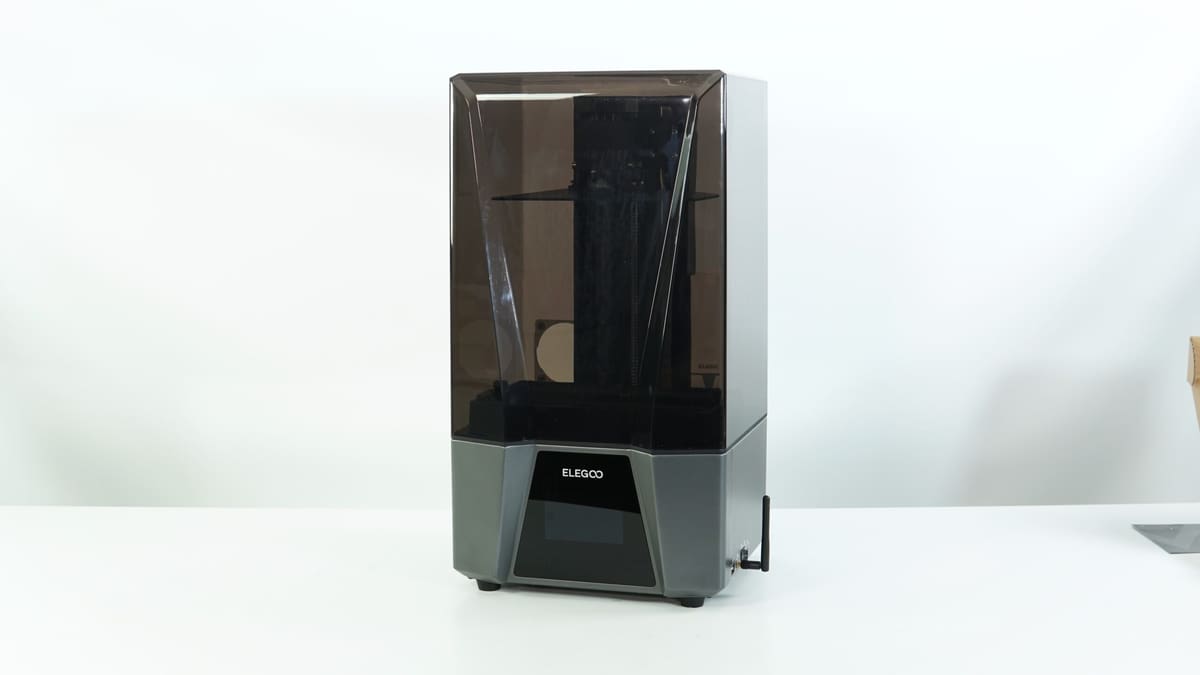
What’s Great
- Bleeding-edge resolution
- Useful Wi-Fi connectivity
- Top all-round performance
Elegoo’s pricing model is pretty wild, with last year’s flagship price tag dropping hard to make room for this year’s printer. It’s a big win for thrifty spenders, as it means that for $300, not much more than our sub-$200 pick, you can pick up a Saturn 3 Ultra, Elegoo’s top-spec model of last year, instead.
The biggest concession you’re making is that the Saturn 3 Ultra is a mid-size printer that would benefit from having a hinged, flip-style lid. It doesn’t have one, though, so you have to live with lifting its hefty grey bucket lid whenever you’re fishing out a print or topping up the resin.
In classic Elegoo fashion, the Saturn 3 Ultra is a workhorse, capable of finely detailed prints across its build area without the need for cajoling or praying to the machine gods. At least, that has been our experience using it in the lab. You get ~219 x 123 x 260 mm of build volume to work with.
There’s a ventilation port on the back of the printer, for those running a hose to a window or extractor. Likewise, you can plug in a replaceable USB-powered air filter, which will quietly run to reduce the smell coming from the resin.
The Saturn 3 Ultra can achieve up to 150 mm/s print speeds thanks to its use of ACF film in the resin vat. Some claim this film isn’t the best and can result in artifacts on your prints. In our experience, nuh-uh. But, if it does, the film is an easily swappable consumable – other films, including newer formulations of ACF, which would maintain the high print speed, are available.
Under $200: Elegoo Mars 5
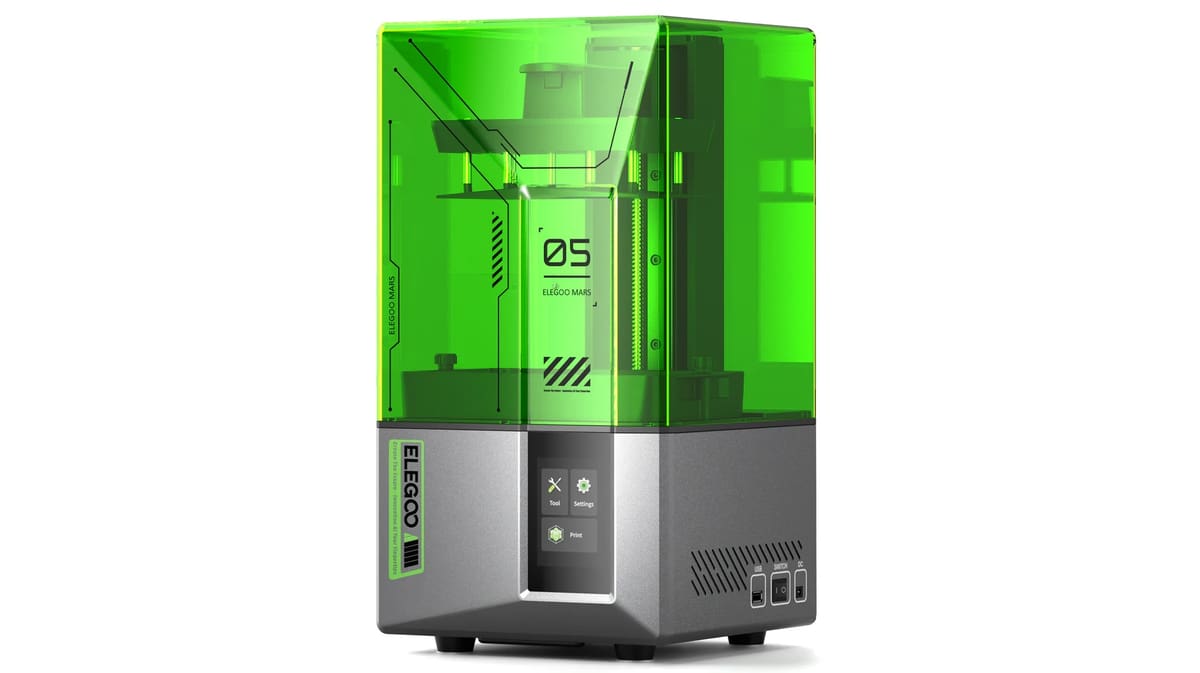
What’s Great
- Resin level & print failure smarts
- Useful Wi-Fi connectivity
- Self-leveling
The Elegoo Mars 5 is the latest of Elegoo’s “cheap and cheerful” base Mars model of 3D printer, priced at ~$180. While it won’t print as fast as the pricier Mars 5 Ultra (primarily because it lacks a vat tilting mechanism), it does offer a suite of sensors to help you get through your prints without much hassle.
The Mars 5 features Elegoo’s new style of print plate, which sits on springloaded standoffs – this is, ostensibly, the plate leveling mechanism, allowing you to unbox and start printing without the need for a pre-print level, minus the resin and with the printer in a clean state. This is a key feature for beginners, reducing the frustrations in preparation of a print.
Unusually for a sub-$200 resin 3D printer, the Mars 5 features a full systems self-check, letting you know if the printer is in good operable condition.
Size-wise, you get ~143 x 89 x 150 mm of build volume to work with, which puts the Mars 5 firmly in “small” resin 3D printer territory.
Overheat protection and the option to enhance the printer further with add-ons that plug into the printer’s in-chamber USB port, such as a heater (useful for ensuring the resin is in a good state for printing) or an air filter, to help reduce the smell from the resin, all of which let you customize the setup to your situation.
Overall, the Mars 5 is a compact, smart 3D printer that offers great value for money.
Small: Anycubic Photon Mono 4 Ultra
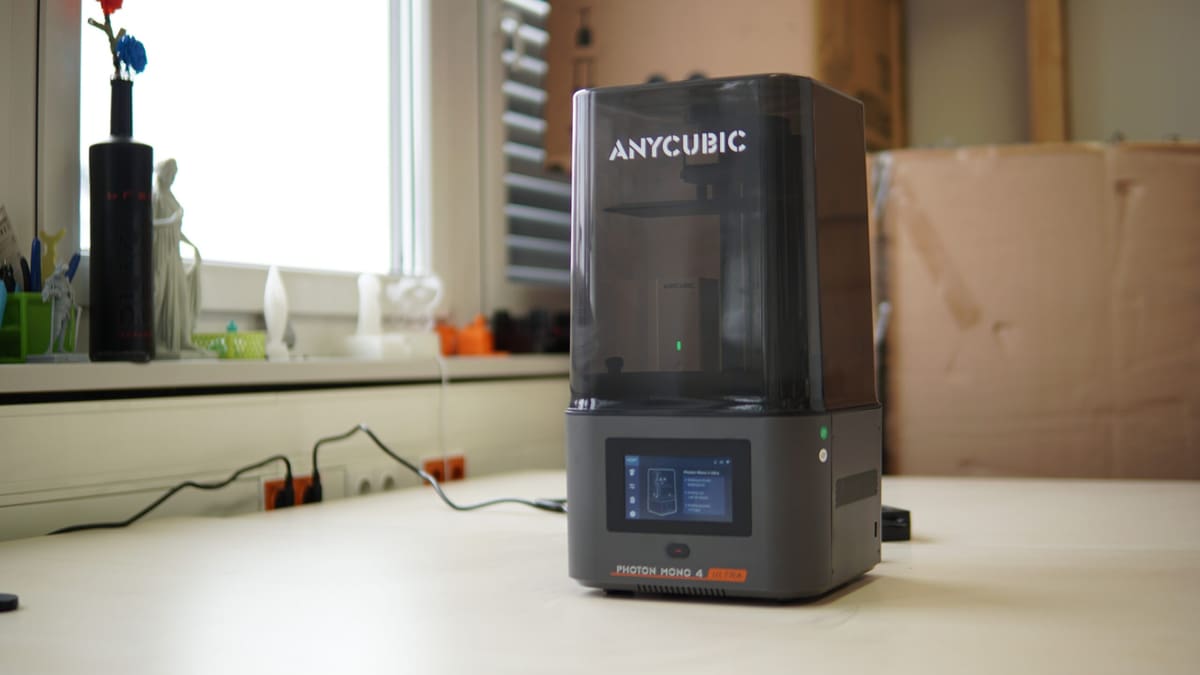
What’s Great
- Packed full of fail-safes to save you material and time
- Wi-Fi and app connectivity
- Capable of quick printing
We were big fans of the Anycubic Photon Mono 2 for its low-cost low-frills approach to resin 3D printing. The Anycubic Photon Mono 4 Ultra, $259, is the ultimate glow-up.
Anycubic reserves the odd numbers for its “main” M-series. We don’t know why. Regardless, the Mono 4 Ultra earns its name well and is remarkably feature-packed for its stature and price. It is, in many ways, a mini flagship 3D printer.
Beneath its lightweight bucket lid lies a ~153 x 87 x 165 mm build volume – sufficient for minis, terrain, jewelry, and the gamut of typical resin 3d prints. There’s space for an in-chamber air filter (sold separately), while a 10K 7-inch LCD provides the framework for 17 x 17-micron resolution in the X- and Y- axes.
The Mono 4 Ultra’s UI borrows from the M7 series – an evolution of the one the company introduced with the Mono M5S back in 2023 – and presents a marvelously clean and logical array of controls and options for using the 3D printer.
A guided setup wizard walks you through the first power on of the machine, with self-checks taking over from there. That’s right, this mini Mono knows thyself and can tell you when something is wrong. “Wrong” in this case can mean insufficient resin to complete the job at hand, and prints failing to adhere and sitting stuck in the resin vat (zero force at layer change). It’s a smart cookie and a godsend for saving time and money on wasted resin when things don’t quite work out.
ACF film comes as standard in the resin vat, allowing print speeds (using Anycubic’s high-speed resin – other high-speed resins are available) in the region of 120 mm/h, although as is always the case, your mileage will vary based on the resin you use and printing parameters for the job.
Cloud functionality is there if you want it, pulling models and slicing in the cloud per Anycubic’s MakerOnline repository, as is printer monitoring and control. You can choose not to use this and simply ferry prints via USB.
Anycubic tells us a LAN mode is coming this year, which is very exciting and would make for a great security improvement over the company’s historically shaky past on this subject.
Mid-Size: Elegoo Saturn 4 Ultra
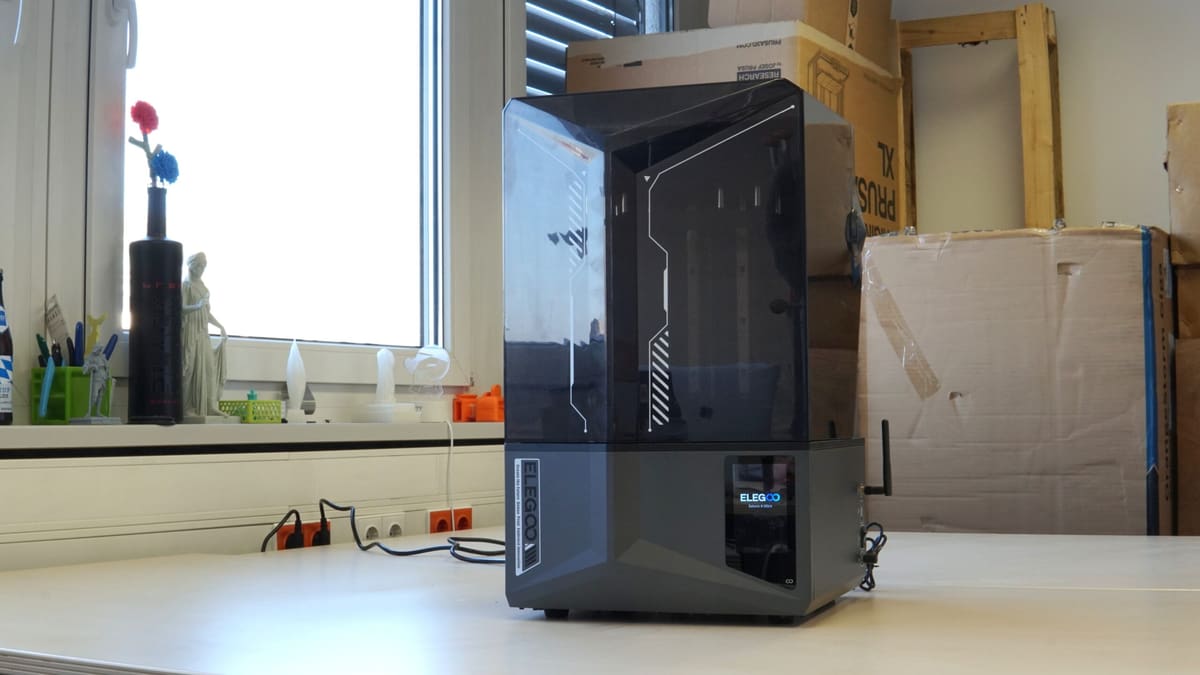
What’s Great
- Capable of fast, high-res printing
- Resin level & print failure smarts
- Well-implemented Wi-Fi connectivity
The Elegoo Saturn 4 Ultra is a mid-size resin 3D printer, which is just about where its being “mid” ends. A high-resolution LCD sits atop Elegoo’s new-for-this-generation vat tilt mechanism, which the company says reduces peel force at layer change, thereby reducing overall layer time.
The printer drips quality, from the reassuring tilting lid, to the self-checking and print monitoring systems. It’s internet-connected and is, natively, fully operable with all popular third-party slicers, plus Elegoo’s new Satelite slicer, which promises a complete, beginner-friendly experience that features all the tools you need. We’ve not tested Satelite yet, so can’t speak to that aspect, but the workflow using most popular slicers is functionally effortless.
In testing we found the Saturn 4 Ultra met every task we threw at it with no memorable hiccups. You get a ~218 x 122 x 220 mm build volume, and Elegoo benchmarks the printer as capable of printing up to 150 mm/h. This number will depend on the resin you use and its idiosyncrasies for curing and timing.
At $399, the Saturn 4 Ultra is tremendous value for money. Elegoo has just launched a slightly higher resolution version, the Saturn 4 Ultra 16K ($499), which ekes out an impossible-to-discern bump in print quality and adds features like a heated resin vat and improved camera setup.
There’s a fun unintentional aspect to the Saturn 4 Ultra that fits its space-themed naming: the sound the tilt vat makes on booting the printer. As it performs its self-checks, it’s a dead ringer for the “wooooh” of air escaping from human Bender (Futurama – season 4, episode 3). You’re welcome.
Large: Anycubic Photon Mono M7 Max

What’s Great
- Self-diagnostic smarts
- Heated vat as standard
- Time- and resin-saving features
Anycubic’s new M7 series of resin 3D printers are a comprehensively decent bunch, making massive strides on the mish-mash of M3 and M5 printers that came before.
Nowhere is this more exemplified than in the M7 Max, which boasts a sweeping 298 x 164 x 300 mm print volume. While it’s not the largest build area in the desktop space (our previous pick, the Phrozen Sonic Mega 8KS, topped it slightly in all directions) the M7 Max offers many features to help ensure the success of the massive prints you’ll be pulling off the print plate. That, and it’s attractively priced at $849.
In addition to the myriad force sensors to detect the presence of enough resin, foreign objects, and successful peel separation from the resin vat (all common across the M7 series), the M7 Max has a heated resin vat to ensure the appropriate printing temperature for the resin – an important catalyst in resin 3D print success.
Helping to speed your prints along is Anycubic’s “Intelligent Release 2.0” algorithm, which adjusts the layer lift height during the print, potentially saving time across the duration of what will, inevitably, be a several-hour job.
In the time we’ve had it running in the All3DP lab, small design touches have endeared this printer to us. For one, a hinged flip lid is, in our view, essential on larger machines like this; particularly if, like us, you run them in an enclosure with air filtration where space may be at a premium. There’s also a hook to hang the build plate post job to let resin drip back into the vat.
As is common across Anycubic’s non-budget 3D printers, cloud operability and connectivity are present, letting you keep tabs on your printer’s status, maintenance schedule, print jobs plus the sundry model-related functions Anycubic offers via its MakerOnline model repository.
The company informs us that a LAN mode is coming soon, which will allow you to use the remote functionality locally, disconnected from the internet. Given recent controversies, this will be a very welcome thing that only improves Anycubic’s hardware in our view.
Beginners: Elegoo Mars 5

What’s Great
- Resin level & print failure smarts
- Well-implemented Wi-Fi connectivity
- Self-leveling
It’s usually pretty solid advice for beginner machines to go with something inexpensive and simple. That is very much the case with resin 3D printing.
Many of the arguments we made for the Mars 5 being a great 3D printer under $200 carry over here. For ~$180, you get a resin 3D printer that’s effortless to set up and smart enough to tell you when something isn’t right for the printer or print, such as insufficient resin in the vat, or subsystems falling outside of acceptable performance. The build volume runs to ~143 x 89 x 150 mm, in the same ballpark as our best small resin 3D printer pick, the Anycubic Photon Mono 4 Ultra.
Elegoo set a standard for budget resin 3D printers many years ago and in 2025 it continues to do so. It’s not a revolutionary 3D printer, but it does enough to offer the better ideas of today’s flagship models in a punchy, sub-$200 package that’s uncomplicated to set up and start using.
What's Changed?
Here’s everything that’s changed over the last 12 months:
Update – February 17, 2025: Wholesale changes to this guide as we tip this wheelbarrow over and refill it with contemporary recommendations that give you the best resin 3D printing experience.
Update – February 19, 2024: We’ve gone hands-on with the Phrozen Sonic Mega 8K S, and it’s rather good. It replaces our previous large-format resin recommendation, the Sonic Mega 8K. Also, the Elegoo Mars 3 is out of stock everywhere and seemingly discontinued. We’ve replaced it with the Anycubic Photon Mono 2, a similar, low-cost, high-resolution 3D printer.
How to Pick the Best Resin 3D Printer
High on your list of criteria when choosing a resin 3D printer should be ease of use — the features that make printing cleaner and more convenient. Does the printer’s resin vat have pegs to raise it above a dirty benchtop? How easy is it to remove the print plate? How is the resin vat fixed in place? All are questions you should ask yourself because these are the things that make working with the printer a better experience.
Beyond this, when shopping for an LCD-based resin 3D printer, the size of the LCD screen and its pixel count and, consequently, the printer’s resolution will be decisive factors in helping you pick one machine over another. Don’t be fooled by manufacturers using high-resolution standards (such as 4K, 8K) to indicate higher resolution prints; it’s the size of the LCD that masks the UV light inside in combination with the pixel count that dictates resolution.
While small and large resin 3D printers look and function alike, printing large presents its own set of challenges. In general, the larger the print, the more physical force it is exposed to during the printing process, which requires extra care when preparing the print to sufficiently support the model. Not to mention the additional weight of components, the print itself, the larger reserve of resin in your vat, and the potential for larger messes to clean up should the print fail or you have an accident in the cleanup. Bigger isn’t always better.
Material costs of running a resin 3D printer extend beyond just the printable materials. In addition to the transparent release film lining the resin vat, LCD-based resin 3D printers also contain consumable hardware in the form of the masking LCD. A monochrome LCD’s (commonplace in 2023) finite lifespan will take you to around 2000 hours of printing before degradation kicks in and starts to impact the quality of your prints.
Finally, pay particular attention to your software options with a resin 3D printer. Some inexpensive printers (not many, mind) lock you into proprietary software lacking features and support. Open compatibility with the top current and free software such as Lychee and ChiTuBox Basic can give you flexibility in your printing.
Professionals and businesses may find more use in our guide to the best industrial and professional resin 3D printers, which details the characteristics and considerations of resin 3D printing in commercial and design applications.
How We Test
If there’s one thing that testing a lot of 3D printers has taught us, it’s that maintaining a broad benchmarking scheme for 3D printers is impractical for getting a sense of what a 3D printer is like to use and live with. Holding a sub-$200 self-assembled printer for hobbyists to the standard of a $6,000 production machine designed to handle engineering-grade materials won’t tell you that the former is a breeze to set up and the latter a tangled web of firmware updates, buggy systems, and unreliable performance.
We want our reviews and buyer’s guides to cut straight to the chase. What is it like to use a printer? What are the defining features like? What didn’t we like? And, more importantly, is it worth the money? We don’t want to get bogged down benchmarking numbers out of context or hung up on issues affected by more variables than we can control.
Who Are We Testing For?
Our buyer’s guides and reviews take the intended end user of a 3D printer into consideration. We imagine what they’re likely to do with it and focus the testing on challenging this. If we have a large-volume printer, for example, we’ll be printing – surprise, surprise – large prints, making use of the entire bed, and checking the performance at the limits of Z-height.
Other points of consideration for what makes the best 3D printer include ease of use, supporting software, and repair options. If something goes wrong, how easy is it to fix the machine? Does the documentation or customer service provide adequate information?
We strive to answer all these questions and more in our quest to find the best 3D printer for you.
Why Should You Trust Us?
Trust is important to All3DP, so our product testing policy is strict. When sourcing test units from a manufacturer, we do so under a zero guarantees policy. We make no guarantee of coverage in exchange for the printer, and the first time a manufacturer sees what we think is when we publish the content.
If a manufacturer doesn’t reclaim the unit after testing is complete, it is donated to a local cause or goes into deep storage for responsible disposal later. We occasionally buy machines for testing, too. In such cases, machines purchased by All3DP either remain in the office for team usage or are donated or disposed of in the manner described above.
Manufacturers or benefactors donating units for review do not influence the outcome or content of the reviews we produce. To the best of our ability, we will investigate abnormal issues with the manufacturer to glean better context or get insight into their awareness of the problem. But we make no excuses for poor design or bad QA.
How We Monetize Our Content
One method we monetize our content at no additional cost to the reader is through affiliate product links. If you click on a shopping link featured in our buyer’s guides and reviews, we may receive a small commission from the store if you make a purchase. This is at no additional cost to you. For more meaty content policy details, we cover it all in the advertising and commercial activities section of our terms of use.
Which 3D Printer is Best for Me?
For most readers, our top recommended 3D printers are your best bet in a given category.
But, facing the fact that there is no one-size-fits-all solution to home 3D printing, we’re here to help. Here are some pointers to orient you in this terminologically dense but wonderful world. (A word on terminology, we have a handy glossary of terms to know at to bottom of this article.)
Beginner’s printers
Many 3D printers pitched for “beginners” or children go to such lengths to baby the user that they quickly become claustrophobic experiences. You will encounter more limitations than possibilities as your experience grows. If you aren’t satisfied with a “beginner” 3D printer’s features, we’d recommend a budget pick instead. You’ll save a little money, and the opportunity to learn by doing is far greater. And if something goes wrong, there are giant tribes online for each printer that have already asked and answered every question under the sun.
Follow the crowd
While the general quality of budget 3D printers has dramatically improved in recent years, quality control is often lacking. While manufacturers with large user bases are adapting to meet the demands of their newfound fans, including better customer support, there are usually better wells of knowledge to be found in the owners themselves, who contribute to the vast forum knowledge bases for some 3D printers.
Reviews matter
We have zero obligation to manufacturers to sugarcoat what we find, and the first time they read it is when you do, too. That’s why you can trust our reviews. We don’t pander to anyone, and our experience with the printer is what you read on the page.
If you can’t find any information about a printer you’d like to know more about, let us know at editors@all3dp.com.
Understand the costs
A 3D printer for the home is rarely ever a one-and-done investment. Besides the continual purchase of materials, maintenance costs on perishable printer parts can stack up – think nozzles on an FDM printer or FEP film on an LCD-based resin 3D printer machine. Of course, parts can wear down or break, too, meaning sourcing replacement parts is a sensible consideration if you plan to print long-term. Printers with roots in the RepRap movement and open-source designs will be easiest to source parts for, with off-the-shelf components part and parcel of the design ethos behind them. Enclosed-design printers aimed at beginners may offer the gentlest introduction to printing, but your options to source spare parts will often be limited to the manufacturer. That’s if you can even get to and diagnose the problem.
Know why you want to 3D print
The thrill of a new hobby will only sustain you so far. Being the desktopification of an otherwise complicated manufacturing process, expect to encounter, sooner or later, problems with a home 3D printer – even the occasional show-stopping issue. Having an end goal in mind for your printing gives you purpose and a reason to learn the solutions to the problems. Printing simply because it looks cool will result in a small mountain of useless doodads and, eventually, disinterest at the hands of cost, frustration, and the buildup of useless plastic trash.
When you do know, pick a printer that will make it easier
Most home 3D printers are single extrusion fused deposition modeling machines, meaning a single printable material extruded through a single nozzle. Versatile enough for many applications through material compatibility, they’re safe machines to start with. But if you know you need to print objects with challenging geometries or semi-enclosed volumes, a dual extrusion printer would make your printing far easier. Likewise, single objects that need to have different material properties will only be achievable with dual extrusion. A resin printer will be the way to go for high-detail miniatures. Understand the technologies to find a printer that best suits your needs.
Pick a printer appropriate for your space
While the size of FDM 3D printers can vary greatly, the spillover is small. You’ll get some emissions from the filament melting, cloying the air, making it inadvisable to spend prolonged periods nearby. Generally speaking, the cleanup is minor and relatively easy to contain, depending on the models you print.
Resin 3D printing, however, is dramatically different and has unique demands that should make you think twice before investing. To varying degrees, the resin is smelly and toxic to you and the environment. It requires dedicated cleanup stations and personal protective equipment. You typically need 95 %+ isopropanol to clean prints and dissolve uncured resin from surfaces.
All printers should be operated in well-ventilated spaces, but this applies doubly to resin 3D printers.
Kickstarter – It’s complicated
While many excellent 3D printers have gotten their big break on Kickstarter, there’s the unavoidable issue that the platform is not a store. You are not buying a printer when you commit money to a campaign on Kickstarter; you are backing a vision. It’s putting money into the pot to help a company or person trying to achieve something.
You get nothing in return if a project is grossly mishandled and the money disappears. Often what you do get is the beta version of the product. You are paying for early access and all the wrinkles across all stages of the product that come with it.
We’re seeing more big-name companies turning to Kickstarter than ever to launch their products – it’s a safe way for them to gauge demand and drum up some interest against the pressure of a ticking countdown. Despite many companies being capable of outright launching products, they go cap-in-hand to enthusiasts with the promise of shiny new tech. Don’t be that user unless you absolutely must be the first to use a product and have money you can afford to lose.
We don’t think it’s worth the risk, but in the interest of cool new tech, report on new campaigns with our news coverage. You will never see a Kickstarter 3D printer in our buyer’s guides unless it has completed its campaign and the printer is widely available at retail, with all the protections that come with buying from a store.
Best Professional 3D Printers
But where’s the UltiMaker? Or Formlabs? What about Raise3D? Desktop Metal?
In the past, we’d list the best professional 3D printers alongside what we consider consumer or hobby-oriented machines (the printers we mainly focus on). An apples and oranges comparison, we know.
With this in mind, we created All3DP Pro, a wing of our content exclusively covering the professional applications of 3D printing and additive manufacturing solutions. Here’s a selection of articles covering the best 3D printers for professional use to get you started.
- Top 6 Professional 3D Printers Under $10,000
- The Best 3D Printers for Small Businesses in 2025
- The Best Metal 3D Printers in 2025
- Best Desktop-Size Carbon Fiber 3D Printers: Our 10 Picks
- The Best Carbon Fiber 3D Printers for Industrial Use
- SLS 3D Printer Buyer's Guide 2025
- The Best Independent Dual Extruder (IDEX) 3D Printers
- The Best Ceramic / Pottery 3D Printers
- The Best Dental 3D Printers 2025
- PEEK 3D Printer Guide & All You Need to Know
Glossary of Terms
Choosing the best 3D printer is tricky, not least because the terminology surrounding 3D printing is dense. Here are some need-to-know terms, their explanations, and useful links to help you on your way to 3D printing mastery.
FDM: Fused deposition modeling, otherwise known as FDM, is a 3D printing process that extrudes heated thermoplastic material through a moving nozzle to build an object layer by layer. FDM is a trademarked term, which led to the RepRap open-source movement to coin the alternative phrase “fused filament fabrication” (FFF), but the two are interchangeable.
Filament: Filament is the base material used to 3D print objects via FDM. The filament is typically a solid thermoplastic fed to a print head, heated to its melting point, and extruded through a small nozzle. Filament is commonly available in spools of either 1.75 mm, 2.85 mm, or 3 mm diameter widths – dimensions that dictate the printers that can use them.
G-Code: G-code is the machine language used to instruct computerized tools such as 3D printers. Giving coordinates and instructions for tool heads and other non-movement functions, it is almost exclusively generated by slicing software. It comprises a library of commands to control specific actions like motion, speed, rotation, depth, and other related switches and sensors used in a machine’s operation. You can get to grips with G-code in no time with our guide to G-code commands.
Heated bed: This is a build plate that is heated so that the few layers of extruded plastic are prevented from cooling too quickly and then warping. A heated bed is essential for working with ABS or PETG materials but not so much with PLA.
Hot end: This is the cluster of components that heat and melt the plastic for deposition through the nozzle.
Extruder: Used by some to describe the entire system of parts that pushes and melts filament, extruder can also refer specifically to the motor and accompanying gears that grip the filament, feeding it to the hot end. How the extruder is arranged can affect the printer and its capabilities. There are two common arrangements: Bowden and direct. It’s a messy subject with overlapping terms and technical explanations; our guide to 3D printer extruders gives you all the knowledge to make sense of it.
Bowden: A style of extruder that sees the extruder motor positioned away from the hot end – typically the structural frame of the printer or on one end of the X-axis gantry. So-called for the Bowden cable and its action of allowing a wire to move freely within tightly constraining tubing, the Bowden extruder feeds filament through a PTFE tube directly into the hot end.
Direct Extruder: The other commonly seen extruder type, a direct extruder sees the extruder motor and associated feeding mechanism mounted directly to the hot end, with barely any distance between the feed and the melt zone of the hot end.
Dual Extrusion: Some 3D printers carry two extruders/hot ends, allowing them to incorporate multiple colors or materials into the same print job. While the obvious appeal comes from the possibility for decorative two-tone prints, the real benefit of dual extrusion systems is combining different materials, such as dissolvable support material, to enable the printing of otherwise impossible geometries. It’s a deep topic worth exploring more in our guide to all you need to know about dual extrusion.
PLA: Polylactic Acid, otherwise known as PLA, is a thermoplastic commonly used as a material for printing with FDM 3D printers. It’s easy to work with and is available in many colors and finishes. PLA is somewhat brittle – don’t expect to print strong items with it – but it remains popular for decorative printing thanks to its low cost. You can learn more about PLA in our guide dedicated to the topic.
SLA: Stereolithography is a 3D printing technology that falls under the broader process of vat photopolymerization. The term is often (incorrectly) used to describe all methods of vat polymerization – really, it’s a particular technology that uses a directed laser beam to trace layers into a vat of liquid photopolymer resin. Alongside SLA, other technologies are considered vat polymerization.
Resin: The material used in desktop SLA, DLP, and LCD (MSLA) 3D printers. A blend of chemicals that includes a photoinitiator, resin solidifies under ultraviolet light. Highly toxic and difficult to clean up after a spill, care, attention, and personal protective equipment are musts when working with resin. It is an unpleasant material, and wastage must be disposed of in accordance with local laws. Despite all the warnings, it’s the only way to go for intricate detail.
LCD 3D Printer: A common term for resin 3D printers that use an LCD as a layer mask over UV light. The de facto standard in inexpensive resin 3D printers, the technology is cheap and widely used. The LCD panels are consumable, though, with monochrome LCDs typically having lifespans in the low 1,000s of hours.
MSLA: Mask stereolithography (MSLA) is a term coined by Structo but popularized by Prusa Research. It refers to, basically, the LCD 3D printer as described above.
Micron: One-thousandth of a millimeter. This unit of measurement is commonly used in 3D printing as a value to indicate accuracy, resolution, or surface finish.
Slicer: 3D printing works by building an object layer by layer. A slicer is a program that divides a 3D model into flat layers and generates the machine code for the printer to trace out said layers. The output of a slicer for FDM 3D printers is typically G-code, which gives instructions and coordinates for the printer to execute. Our deep dive explaining what exactly a slicer is gives good foundational knowledge. Many popular slicers are free and open source. Others are proprietary and machine-specific. It’s an essential tool for successful 3D printing.
STL: STL is the most popular file format for 3D printing. Developed by 3D Systems in the ’80s, the STL file type only contains the surface geometry of a 3D object. Despite industry efforts to move onto more efficient and data-rich formats such as 3mf, STL endures and is the most commonly found 3D model file type on popular 3D model file repositories. We explain in more detail in our guide to what exactly STL is.
Open Source: The term given to a product, typically software, but also applicable to hardware that is freely open for others to modify and redistribute according to their needs. In 3D printing, this is often in the spirit that individuals are free to modify, improve, and share changes to the source material for others to test, iterate, and reciprocate. Open source licenses govern the fair and correct usage of open source works, giving terms and conditions that ensure the freedom of access to the creation and any derivatives.
RepRap: A project started in 2005 by Dr. Adrian Bowyer, a mechanical engineering lecturer at the University of Bath. Created to develop a replicating rapid prototype, a low-cost machine capable of printing replacement parts for itself or other new machines. The vast majority of desktop 3D printers stem from the work laid down by the RepRap project. We have a fascinating alternative RepRap Wiki page on the topic if you want to dig deeper.
License: The text of "Best Resin 3D Printers in 2025: Our Picks in 9 Categories" by All3DP is licensed under a Creative Commons Attribution 4.0 International License.
CERTAIN CONTENT THAT APPEARS ON THIS SITE COMES FROM AMAZON. THIS CONTENT IS PROVIDED ‘AS IS’ AND IS SUBJECT TO CHANGE OR REMOVAL AT ANY TIME.

